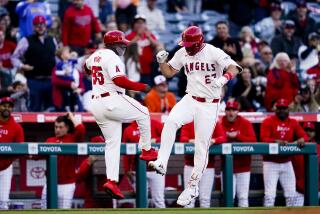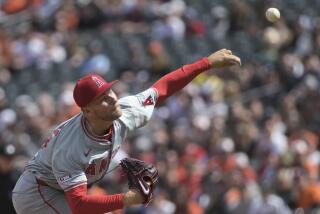McGregor on Target in Comeback : Oriole Pitcher Looks Sharp After a Winter of Hard Work
- Share via
WEST PALM BEACH, Fla. — It was 16 years ago this month that Scott McGregor made his debut for a major league team and, coincidentally, it came in the same stadium Monday where he began his last-chance comeback attempt.
McGregor passed the first checkpoint, pitching three scoreless innings and looking sharp in the Baltimore Orioles’ 8-4 loss to the Montreal Expos.
He was one of the bright spots on a day when John Habyan failed his first spring test, allowing five runs and seven hits in three innings. It was also a tough season debut for reliever Dave Schmidt, who allowed three runs and five hits in two innings.
The Orioles’ offensive star was rookie Pete Stanicek, who started at second base, played the entire game and was on base four times with a home run, two singles and a walk. The only other Oriole with two hits was Fred Lynn, who homered and singled.
McGregor’s performance is important because of who he is and what he has meant to the Orioles, having been a cornerstone for their great teams of the ‘70s and ‘80s. After 2,214 innings and 138 victories, McGregor is only 34 and coming off a hard winter of work.
Monday, he looked a lot like the McGregor of 1983, throwing high fastballs, low change-ups and keeping hitters off balance.
“I’m right on schedule,” McGregor said. “The ball was sinking for me and I got some ground balls. I’m still a little shaky working from the stretch, but so far everything feels good. I feel the way I felt last spring, and when we left Florida then, I thought I would win 20 games.”
A rotator-cuff injury ended his 1987 season prematurely, and the Orioles have doubts about his ability to come back. But he has $2.3 million remaining on his contract for the next two seasons, and if he pitches well, he will earn a spot on the team.
McGregor’s status is one of the few things clear about the Orioles. The most confusing part of their spring is the competition for the left field job. They came here saying that Stanicek would be given a chance to make the switch from second base. Their logic was that Stanicek might be the leadoff hitter they’ve so desperately needed since Al Bumbry was released in 1984. Stanicek stole 46 bases last season at Class 2-A Charlotte, 3-A Rochester and Baltimore, and stole 77 the year before in Class A Hagerstown.
He hit .300 in three minor league seasons and succeeded on 80.6% of his steal attempts. All of that excited a franchise that recently has had a series of poor leadoff hitters, a big reason the Orioles were next-to-last in runs last season. But through three games, Stanicek has played just six innings in left and had one ball hit to him.
Even Monday, when his offensive skills were on display, Manager Cal Ripken Sr. talked mostly about Stanicek’s throwing error in the seventh inning and came close to dismissing Stanicek’s offensive numbers.
“How many hits did he have today?” Ripken snapped. “Three? How many did he have before today? None, right? (Stanicek was zero for five before Monday.) Well, that’s not too good.”
But Ripken said he intended “to find out if he can play left field. I’ve got a lot of guys I want to look at besides him.”
Likewise, it appears that Ripken’s statements that Jim Traber might get a chance to play left may have been lip service. Traber has been used exclusively at first base, where Eddie Murray has missed only 59 starts in 11 seasons.
Traber was one of last spring’s early cuts, and is beginning to get a bad feeling about 1988.
“I just hope it doesn’t stay this way,” he said. “If it does, it’s going to be the same as all my other spring trainings. I know they’ve got guys they want to look at, but I wish just one spring I could be one of those people.”
More to Read
Go beyond the scoreboard
Get the latest on L.A.'s teams in the daily Sports Report newsletter.
You may occasionally receive promotional content from the Los Angeles Times.










